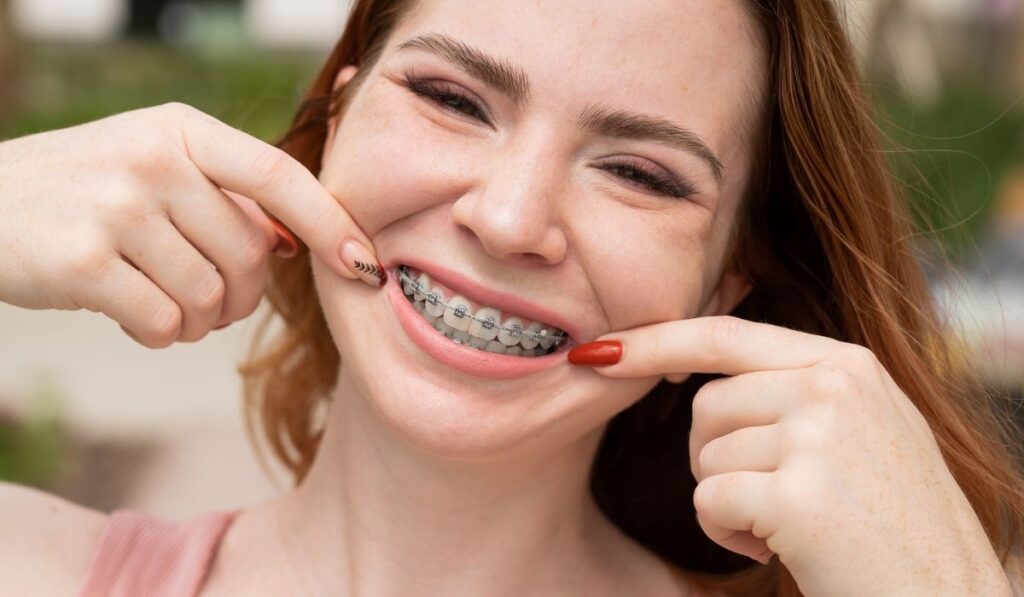Many people have concerns about using braces. These concerns are often rooted in the fear that using braces can change the shape of someone’s face. Some say it can make the nose more prominent and the cheeks bigger. Is this true?
While braces might elongate your jawline, they don’t directly affect your cheeks or nose. For example, when correcting malocclusions, braces can move the teeth towards the back of the mouth to align the jaw. Changes to your jawline may give the illusion that other parts of the face have changed.
To understand this answer better, let’s take a closer look at how braces work and how they can affect your appearance. It’s good to know just how braces will (and won’t) effect your appearance beyond the rows of metal on your teeth!
How Do Braces Work?

Braces move your teeth into a position that is most optimal functionally and cosmetically by applying constant force and pressure to move the teeth. However, to have an in-depth knowledge of braces, you need to understand how the various parts work together to achieve the desired result.
Brackets
Brackets are the spine that holds the whole braces mechanism together. Brackets are applied to the teeth with a unique adhesive and are attached the archwire. To make the procedure effective, each tooth has its own bracket.
A bracket on each tooth allows the archwire to apply the requisite pressure needed to move each tooth to its intended position.
Elastic
In cases of malocclusion or more severe dental issues, it’s best to have elastics. In these extreme cases, you need additional pressure than what brackets and archwires normally provide. Orthodontists attach elastics to some brackets to increase the force applied by braces on the teeth.
In some cases, elastic might not be enough. You might require devices that add additional pressure for issues like headgear or springs.
The Archwire
The archwire is like the director of a blockbuster or the quarterback of a football team. It dictates the rate or amount of pressure applied on the teeth and jaw to achieve the result needed. The archwire is bent manually or with a computer and then placed through the bracket slots.
The archwire constantly applies pressure to the teeth, and the teeth move in the direction of the applied force. The archwire doesn’t only push the teeth in a certain way, but it also determines how fast the teeth shift.
Throughout treatment, the type and shape of the archwire used will change in order to shift the pace and direction of the teeth movement. In some cases, you begin your treatment with round and light archwires. Then you change them to rectangular and heavier ones as treatment progresses.
Our teeth are rooted in the periodontal ligaments attached to the alveolar bone. Archwire pressure acts directly on the periodontal ligament and shifts the teeth within the ligament and bone.
The amount of pressure applied by the orthodontist on your teeth depends on how your periodontal ligament initially reacts to the archwire. That’s why it is common for you to pay regular visits to your orthodontist to see how the procedure is coming along. They will change the archwire depending on the progress.
Do Braces Change the Shape of Your Face?

Braces do more than widen your smile or straighten crooked teeth. Depending on the specific conditions, using braces can change the structure of your face. When we say facial structure, we are talking about your profile, lips, and jawline.
In young people whose bones and skeletal structures are still developing, there can be noticeable changes to the facial structure. In older people, while there might be some changes to the cheekbone due to movement of the teeth, the overall changes in face shape are gradual and less noticeable.
If you’re wondering whether braces affect things like the shape or size of your nose, we can assure you they don’t. In cases of evident shaping of the upper teeth, like with an overbite, there may be an illusion of a protruding nose following treatment.
When it comes to the shape of your lips, braces can change their position. However, the shift will only occur when there’s a change in the parts of the teeth. Braces have nothing to do with the fullness or shape of your lips.
When it comes to the jawline, you can expect some change in cases of overbite, underbite, open bite, and crossbite. When braces do their work properly, they correct weak chins and widen the smile. So you can expect a carved jawline when you use braces, no matter the age.
Finally, on the subject of face shape, braces don’t radically change the shape of your face. Instead, they streamline the shape of your face, correcting any malformations due to your dentition.
Frequently Asked Questions
Let’s answer some of the common questions for those about to undergo the journey of applying braces or who are just curious about the device and how it works.
Do Braces Change Your Jawline?
Yes, they do. People who want to correct overcrowded teeth, small smiles, or any other teeth defect with braces should expect a change in their jawline. When you are fixing crowded teeth, the braces move your teeth to the back of your mouth by extending your jawline.
Braces correct various malocclusions, like overbite and underbite, by aligning the jaws and correcting the bite issues. Braces also change the position of the jawline, giving it a more symmetrical and natural shape.
Do Braces Make Your Cheeks Bigger?
Braces can change your jawline, reposition your lips, and correct an overbite, but they don’t make your face fuller or your cheeks bigger. When you have orthodontic problems, your face (including your cheeks) might appear distorted or unsymmetrical.
Braces correct the issues that can cause this lack of symmetry and change the profile of your face, but they don’t affect the way your cheeks look.
Can Braces Make You Look More Attractive?
The answer to this question depends largely on how you see yourself and what features you would like to see changed. Those who suffer from any form of malocclusion may find that the braces have removed this problem, ending periods of pain and discomfort, while also improving the look of their faces. Braces can also result in a straighter smile.
When you’ve got a smile you’re proud of, you might smile more often. And what’s more attractive than a nice smile?
To End
Braces do more than correct teeth defects. They can change the way people see you. However, these changes aren’t particularly radical or drastic. In adults, the facial changes often aren’t as noticeable. The changes can be more prominent in children whose bones are still growing.
Braces can enhance attractive features of the lower face, but won’t affect the nose or cheeks. Overall, using braces can make your appearance more symmetric, and that, in turn, may lead to a boost in self-confidence.


